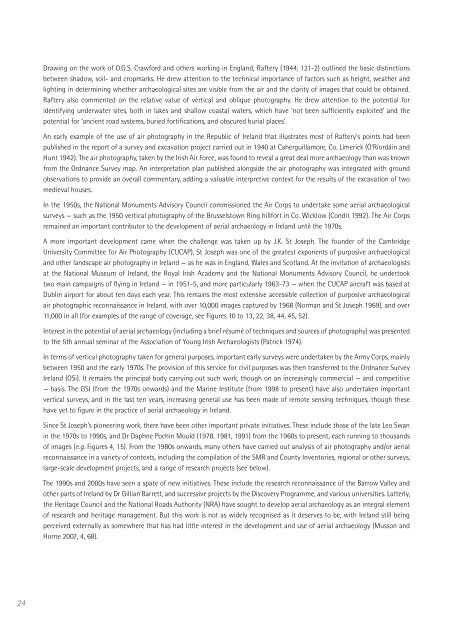Aerial Archaeology in Ireland - The Heritage Council
Aerial Archaeology in Ireland - The Heritage Council
Aerial Archaeology in Ireland - The Heritage Council
You also want an ePaper? Increase the reach of your titles
YUMPU automatically turns print PDFs into web optimized ePapers that Google loves.
24<br />
Draw<strong>in</strong>g on the work of O.G.S. Crawford and others work<strong>in</strong>g <strong>in</strong> England, Raftery (1944, 121-2) outl<strong>in</strong>ed the basic dist<strong>in</strong>ctions<br />
between shadow, soil- and cropmarks. He drew attention to the technical importance of factors such as height, weather and<br />
light<strong>in</strong>g <strong>in</strong> determ<strong>in</strong><strong>in</strong>g whether archaeological sites are visible from the air and the clarity of images that could be obta<strong>in</strong>ed.<br />
Raftery also commented on the relative value of vertical and oblique photography. He drew attention to the potential for<br />
identify<strong>in</strong>g underwater sites, both <strong>in</strong> lakes and shallow coastal waters, which have ‘not been sufficiently exploited’ and the<br />
potential for ‘ancient road systems, buried fortifications, and obscured burial places’.<br />
An early example of the use of air photography <strong>in</strong> the Republic of <strong>Ireland</strong> that illustrates most of Raftery’s po<strong>in</strong>ts had been<br />
published <strong>in</strong> the report of a survey and excavation project carried out <strong>in</strong> 1940 at Caherguillamore, Co. Limerick (Ó’Ríordá<strong>in</strong> and<br />
Hunt 1942). <strong>The</strong> air photography, taken by the Irish Air Force, was found to reveal a great deal more archaeology than was known<br />
from the Ordnance Survey map. An <strong>in</strong>terpretation plan published alongside the air photography was <strong>in</strong>tegrated with ground<br />
observations to provide an overall commentary, add<strong>in</strong>g a valuable <strong>in</strong>terpretive context for the results of the excavation of two<br />
medieval houses.<br />
In the 1950s, the National Monuments Advisory <strong>Council</strong> commissioned the Air Corps to undertake some aerial archaeological<br />
surveys — such as the 1950 vertical photography of the Brusselstown R<strong>in</strong>g hillfort <strong>in</strong> Co. Wicklow (Condit 1992). <strong>The</strong> Air Corps<br />
rema<strong>in</strong>ed an important contributor to the development of aerial archaeology <strong>in</strong> <strong>Ireland</strong> until the 1970s.<br />
A more important development came when the challenge was taken up by J.K. St Joseph. <strong>The</strong> founder of the Cambridge<br />
University Committee for Air Photography (CUCAP), St Joseph was one of the greatest exponents of purposive archaeological<br />
and other landscape air photography <strong>in</strong> <strong>Ireland</strong> — as he was <strong>in</strong> England, Wales and Scotland. At the <strong>in</strong>vitation of archaeologists<br />
at the National Museum of <strong>Ireland</strong>, the Royal Irish Academy and the National Monuments Advisory <strong>Council</strong>, he undertook<br />
two ma<strong>in</strong> campaigns of fly<strong>in</strong>g <strong>in</strong> <strong>Ireland</strong> — <strong>in</strong> 1951-5, and more particularly 1963-73 — when the CUCAP aircraft was based at<br />
Dubl<strong>in</strong> airport for about ten days each year. This rema<strong>in</strong>s the most extensive accessible collection of purposive archaeological<br />
air photographic reconnaissance <strong>in</strong> <strong>Ireland</strong>, with over 10,000 images captured by 1968 (Norman and St Joseph 1969), and over<br />
11,000 <strong>in</strong> all (for examples of the range of coverage, see Figures 10 to 13, 22, 38, 44, 45, 52).<br />
Interest <strong>in</strong> the potential of aerial archaeology (<strong>in</strong>clud<strong>in</strong>g a brief résumé of techniques and sources of photography) was presented<br />
to the 5th annual sem<strong>in</strong>ar of the Association of Young Irish Archaeologists (Patrick 1974).<br />
In terms of vertical photography taken for general purposes, important early surveys were undertaken by the Army Corps, ma<strong>in</strong>ly<br />
between 1950 and the early 1970s. <strong>The</strong> provision of this service for civil purposes was then transferred to the Ordnance Survey<br />
<strong>Ireland</strong> (OSi). It rema<strong>in</strong>s the pr<strong>in</strong>cipal body carry<strong>in</strong>g out such work, though on an <strong>in</strong>creas<strong>in</strong>gly commercial — and competitive<br />
— basis. <strong>The</strong> GSI (from the 1970s onwards) and the Mar<strong>in</strong>e Institute (from 1998 to present) have also undertaken important<br />
vertical surveys, and <strong>in</strong> the last ten years, <strong>in</strong>creas<strong>in</strong>g general use has been made of remote sens<strong>in</strong>g techniques, though these<br />
have yet to figure <strong>in</strong> the practice of aerial archaeology <strong>in</strong> <strong>Ireland</strong>.<br />
S<strong>in</strong>ce St Joseph’s pioneer<strong>in</strong>g work, there have been other important private <strong>in</strong>itiatives. <strong>The</strong>se <strong>in</strong>clude those of the late Leo Swan<br />
<strong>in</strong> the 1970s to 1990s, and Dr Daphne Poch<strong>in</strong> Mould (1978, 1981, 1991) from the 1960s to present, each runn<strong>in</strong>g to thousands<br />
of images (e.g. Figures 4, 15). From the 1980s onwards, many others have carried out analysis of air photography and/or aerial<br />
reconnaissance <strong>in</strong> a variety of contexts, <strong>in</strong>clud<strong>in</strong>g the compilation of the SMR and County Inventories, regional or other surveys,<br />
large-scale development projects, and a range of research projects (see below).<br />
<strong>The</strong> 1990s and 2000s have seen a spate of new <strong>in</strong>itiatives. <strong>The</strong>se <strong>in</strong>clude the research reconnaissance of the Barrow Valley and<br />
other parts of <strong>Ireland</strong> by Dr Gillian Barrett, and successive projects by the Discovery Programme, and various universities. Latterly,<br />
the <strong>Heritage</strong> <strong>Council</strong> and the National Roads Authority (NRA) have sought to develop aerial archaeology as an <strong>in</strong>tegral element<br />
of research and heritage management. But this work is not as widely recognised as it deserves to be, with <strong>Ireland</strong> still be<strong>in</strong>g<br />
perceived externally as somewhere that has had little <strong>in</strong>terest <strong>in</strong> the development and use of aerial archaeology (Musson and<br />
Horne 2007, 4, 68).

















